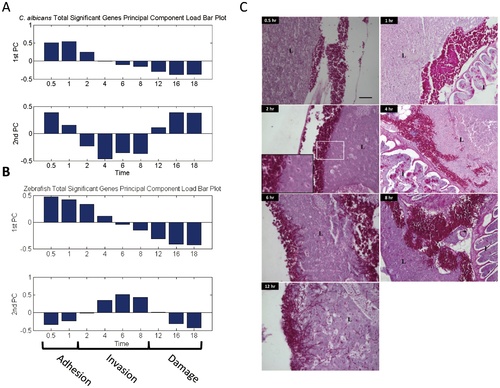- Title
-
Dynamic Transcript Profiling of Candida albicans Infection in Zebrafish: A Pathogen-Host Interaction Study
- Authors
- Chen, Y.Y., Chao, C.C., Liu, F.C., Hsu, P.C., Chen, H.F., Peng, S.C., Chuang, Y.J., Lan, C.Y., Hsieh, W.P., and Wong, D.S.
- Source
- Full text @ PLoS One
|
PC load bar plot and histology of zebrafish infected by C. albicans.(A) The pathogen′s load contributions to the first principal component indicated that the differences in expression between 0.5 and 1 and 12, 16 and 18 hpi represented the axes of largest variation. The load contributions to the second principal components featured the gene expression differences between time points 2, 4, 6 and 8 hpi and 0.5, 1, 12, 16 and 18 hpi. Two principal components sufficiently explained more than 93% of the variations of the zebrafish expression profiles. (B) The host′s load contributions to the first principal component indicated that the differences in expression between time points 0.5, 1, 2 and 4 hpi and 12, 16 and 18 hpi represented the axes of largest variation. The load contributions to the second principal components featured the gene expression differences between time points 6, 8 and 12 hpi and 0.5, 1, 2, 4, 16 and 18 hpi. (C) The histology of zebrafish liver indicated that C. albicans mainly grew in yeast form at 1 hpi and began to attach to the zebrafish liver. 0.5 and 1 hpi were thus defined as the adhesion phase. C. albicans began to transit to the hyphal form at 2 hpi. Invasion to the liver was evident at 4 to 8 hpi. Hence, time points 4 to 8 hpi were defined as the invasion phase, with 2 hpi defined as a transition point for morphogenesis. Beyond 12 hpi, tissue damage, more extensive penetration, and fish death occurred. Time points 12, 16 and 18 hpi were defined as the damage phase. |

